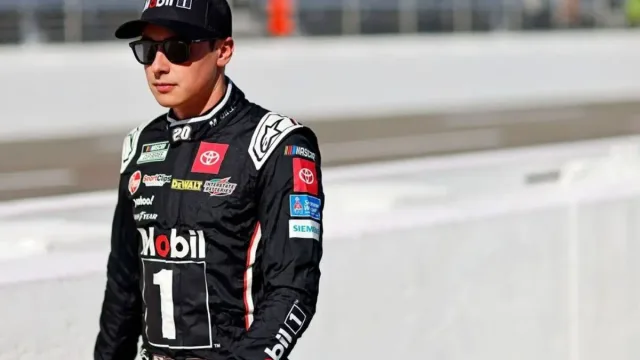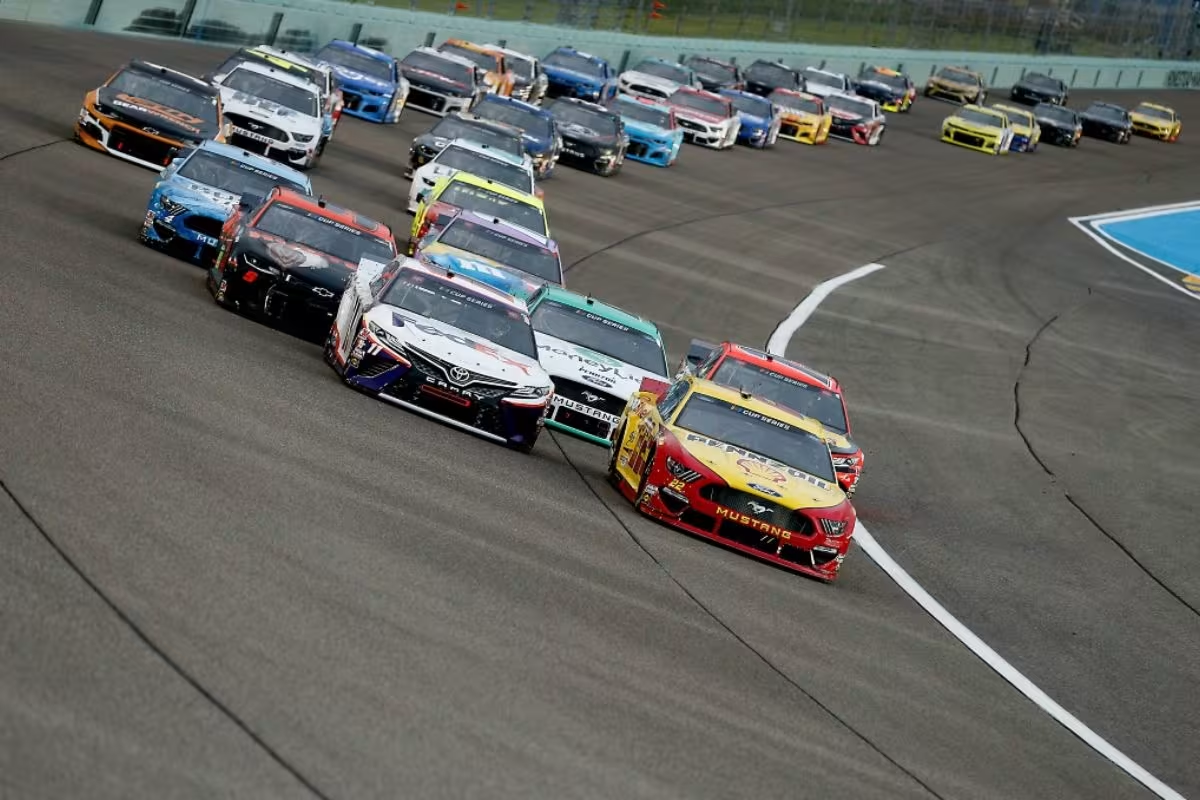Christopher Bell brutally penalized by NASCAR during the Martinsville race, his NASCAR championship hopes crumbled when he received a controversial penalty for wall-riding. This tactic was inspired by Ross Chastain‘s iconic “Hail Melon” move. The penalty not only ended Christopher Bell’s title chances but also sparked debates about NASCAR’s rule enforcement. NASCAR fans raised concerns about safety and the consistency of regulations in the sport. Joe Gibbs Racing was frustrated by limited appeal options, while rival William Byron recognized Christopher Bell’s determination even as he celebrated his own advancement.
Key Highlights
- Christopher Bell’s NASCAR championship aspirations were dashed after receiving a penalty during a critical moment in the Martinsville race.
- The NASCAR penalty was a result of Bell’s risky wall-riding maneuver, reminiscent of Ross Chastain’s controversial “Hail Melon” move.
- NASCAR’s ban on wall-riding was enforced for safety reasons, particularly concerning risks near the crossover gate.
- Joe Gibbs Racing expressed disappointment over the lack of clear regulations in NASCAR regarding wall-riding and the arbitrary nature of the penalty.
- NASCAR fans reacted with mixed emotions, debating the balance between enforcing rules and the spirit of racing in the sport.
Christopher Bell’s Pursuit of a NASCAR Championship Ends with Controversial Wall-Riding Penalty
In NASCAR, every decision can considerably impact a driver’s championship aspirations, a reality that Christopher Bell faced head-on at Martinsville. Entering the race with a tactical mindset, Bell aimed to consolidate his position in the playoff standings, having exemplified remarkable consistency with top-ten finishes throughout the postseason. His performance indicated a driver fully invested in mitigating risk, a quality crucial for traversing the demands of championship rivalry.
However, aspirations turned to turmoil in the final moments when Bell executed a action reminiscent of Ross Chastain’s controversial “Hail Melon” wall-riding technique. Initially, this risky strategy appeared to be a potential game-changer, possibly propelling him to the next stage of the playoffs. Yet, the aftermath revealed a glaring reality: NASCAR’s immediate scrutiny led to a penalty that effectively ended Bell’s championship pursuits.
The sanction raised questions regarding the interpretation of NASCAR rules and the consistency of enforcement, particularly given the recent discussions surrounding the legality of such actions.
Bell’s situation exemplifies the precarious balance drivers must strike between aggressive racing strategies and adherence to regulatory frameworks. The penalty not only halted a promising campaign but also ignited debate among fans and analysts similarly about the evolving nature of competition in NASCAR.
The Rise and Fall of the ‘Hail Melon’ Move in NASCAR
Amidst the constantly changing landscape of NASCAR, the “Hail Melon” move emerged as a revolutionary yet controversial tactic that captivated audiences and polarized opinions. Ross Chastain’s audacious action at Martinsville in 2022, where he rode the wall to gain vital positions, became a defining moment in racing strategy. This unconventional approach not only stunned fans but also eliminated Denny Hamlin from the playoffs, showcasing the lengths to which drivers are willing to go for success.
However, the exhilaration surrounding the “Hail Melon” was short-lived. Safety concerns prompted NASCAR to ban the action, primarily due to the hazardous proximity of a crossover gate in Turn 4. This decision highlighted the inherent tension between creative tactics and the governing body’s responsibility to guarantee driver safety.
Key implications of the “Hail Melon” phenomenon include:
- Creativity vs. Regulation: The move illustrated how ingenuity in racing can clash with established rules, prompting ongoing debates about the boundaries of acceptable tactics.
- Safety Considerations: The ban emphasized NASCAR’s commitment to prioritizing safety, even at the cost of exciting actions that could improve the spectacle of racing.
- Legacy of Controversy: As seen with Christopher Bell’s attempts to replicate the move, the shadow of the “Hail Melon” continues to loom large, shaping the strategies and decisions of future drivers.
NASCAR Senior VP Explains the Rationale Behind Wall-Riding Ban
Following recent incidents on the track, NASCAR Senior Vice President of Competition, Elton Sawyer, provided insight into the decision to enforce a ban on wall-riding tactics. This tactical move aims to uphold both the integrity of the sport and the safety of its participants.
“We obviously were really good on video. As I back up on that, you go back two years ago. We had a situation with Ross here. We went to Phoenix. There was a lot of dialogue with the drivers that that’s not a move that we want to have to make on the last lap. Though we were able to get through Phoenix and had a great Championship race that year…In the all-season meet with the industry, the meet with our drivers – and to a man, that was not a move that they wanna have to make.” – Elton Sawyer
Sawyer emphasized that the rule, specifically rule 10.5.2.6.A, addresses safety violations with the utmost seriousness, which is critical given the high-stakes environment of NASCAR racing.
The rationale behind prohibiting wall-riding is rooted in the potential dangers it poses, particularly in the closing laps of a race. Wall-riding, which involves utilizing the outer wall to gain speed and maintain position, can lead to unpredictable outcomes, potentially endangering not only the driver employing the tactic but also their competitors.
By enforcing this ban, NASCAR seeks to discourage drivers from resorting to unconventional methods that could compromise safety standards.
Sawyer’s remarks highlighted that Bell’s actions during the Martinsville finale exemplified the risks associated with wall-riding. His maneuver through Turns 3 and 4 not only violated the established safety protocols but also illustrated a disregard for the competitive balance that NASCAR endeavors to maintain.
“There was a language in the rulebook. And when you look at it today, he clearly got up against the fence in Turns 3 and 4 and rode the fence all the way off 4 there. And that’s strictly (prohibited) to protect our drivers as well as our fans. So yeah, it’s almost pretty straightforward.”- Elton Sawyer
The enforcement of this ban is therefore a proactive measure aimed at fostering a safer racing environment while preserving the sport’s integrity.
As NASCAR continues to evolve, the focus remains on ensuring that all participants adhere to practices that prioritize safety and fair competition above all else.
Joe Gibbs Racing Faces Disappointment as Appeal Options Run Out
Joe Gibbs Racing is grappling with the fallout from NASCAR’s decision to penalize Christopher Bell, as the team faces a pronounced lack of appeal options. The inability to contest the penalty has left both the organization and its supporters in dismay, particularly as the rationale behind the sanction is shrouded in ambiguity.
Although NASCAR has classified wall-riding as a safety violation, the absence of a clearly defined rule in the official rulebook raises questions about the enforcement of such penalties.
This predicament is compounded by the following factors:
- Lack of Transparency: The decision appears arbitrary to many, as the guidelines governing wall-riding were not explicitly articulated, leaving teams unsure of the boundaries in competitive scenarios.
- Fan Discontent: The penalty has ignited widespread criticism, particularly among Bell’s supporters, who feel that their driver has been unjustly penalized in a critical moment of the season.
- Strategic Implications: With no means of appeal, Joe Gibbs Racing must navigate the consequences of this decision, potentially impacting their strategy for future races and the general morale of the team.
As the dust settles from the Martinsville finale, the consequences of NASCAR’s ruling will continue to resonate within Joe Gibbs Racing.
William Byron Reacts with Mixed Emotions After Advancing
The aftermath of NASCAR’s controversial penalty on Christopher Bell has cast a long shadow over the Championship 4 landscape, prompting varied reactions among competitors. William Byron, who was awarded the coveted spot in the Championship 4, expressed a complex mixture of relief and empathy. While he celebrated the success of his team, he could not ignore the misfortune that befell Bell, a competitor he deeply respects.
Byron acknowledged the existing rules and emphasized his happiness for his own team’s advancement, yet he lamented the situation that led to Bell’s disqualification. Their exchange post-race reflected this sentiment, showcasing mutual respect and fellowship amid competition. Byron’s recognition of Bell’s tenacity throughout the playoffs highlights the intricate dynamics of rivalry and respect in NASCAR.
“I hate it for everyone involved.”
“I’ve never been a part of anything like this, so I don’t really know how to feel. I’m happy for this No. 24 Liberty University Chevy team. I’m happy for us moving on, and we’ll go on and focus on Phoenix.” He added, “I’ll think about this one here at Martinsville (Speedway) with my team. We had a lot of adversity through the second half of the race there. Yeah, I mean we know what the rules are, right? So it is what it is. I wouldn’t say I’m happy, but I’m excited to race for a championship, that’s for sure.” – William Byron
As Byron prepares for the Phoenix finale, he carries the weight of both a hard-earned opportunity and the bittersweet knowledge of a rival’s anguish. This duality encapsulates the emotional landscape of NASCAR, where victory and tragedy often coexist.
News in Brief: Christopher Bell Brutally Penalized by NASCAR
The controversial penalty imposed on Christopher Bell during the Martinsville finale emphasizes the complexities inherent in NASCAR’s regulatory framework. The enforcement of the wall-riding ban, as articulated by NASCAR’s Senior VP, reflects an intention to maintain competitive integrity while maneuvering the evolving dynamics of race strategies.
The outcome impacted Bell’s NASCAR championship aspirations and highlighted the broader implications for Joe Gibbs Racing. As the sport continues to grapple with its rules, reactions from drivers like William Byron reveal the multifaceted nature of competitive emotions within NASCAR.
ALSO READ: Christopher Bell Confronts Tough Reality as He Battles for Survival in Martinsville Chaos



